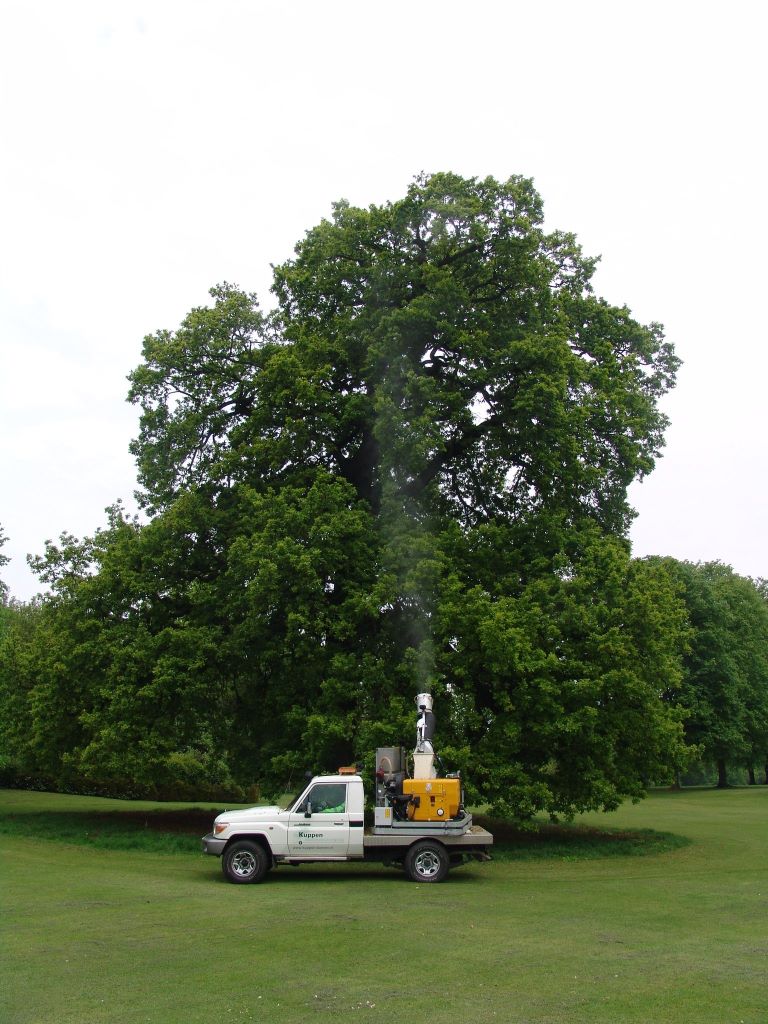Two pesticides are licensed for control of the larvae, or caterpillars, of oak processionary moth (OPM). These are Bacillus thuringiensis var kurstaki (BT) and deltamethrin. Further information about them is available on the Health & Safety Executive (HSE) website.
The status and availability of chemicals can change from year to year, so it is important to check the manufacturer’s label and the HSE website to ensure that there is current approval for the use intended.
BT is most effective against young (L1–L3 growth stage) caterpillars, so optimum timing of applications is crucial. Surveys and monitoring of egg hatch are important to getting this right.
BT and other growth-regulating insecticides are less effective against older (L4-L6 stage) caterpillars. However, deltamethrin can still be applied, provided there is good coverage and spraying takes place while the caterpillars are outside the nests. It is therefore the preferred insecticide for dealing with these later stages as an alternative to caterpillar or nest removal. (See Section 7 – Nest and larvae removal).
BT is often favoured for pest control because of the way it targets larvae, meaning it has less impact on non-target species than deltamethrin can have.
However, where eradication is the objective, such as in the Buffer Zone or Area free from the pest, a single dose of BT will not be fully effective. A second, follow-up spray of BT must be applied seven to 10 days after the first.
A single treatment should be enough in the Established area if the objective is simply to suppress the caterpillar population.
Deltamethrin is less selective, but kills on contact and acts fast. It might be a more appropriate insecticide to use for more-mature caterpillars, which become tolerant of BT.
However, deltamethrin is highly toxic to bees and aquatic life, and particular care must therefore be taken when using this product on or near flowering plants as well as rivers, streams, ponds or other water bodies. Always check the product label for full information.
We strongly recommend that other susceptible oak trees within 50 to 100 metres of an infested tree or trees are also sprayed, on the basis that they are very likely to be infested as well.
There will be special restrictions if the trees are in a Site of Special Scientific Interest (SSSI). SSSIs are protected by law to preserve their special wildlife or geology, and permission from Natural England will be needed before any work is carried out. If you think this might apply, speak to your local SSSI adviser, or contact Natural England on:
Because OPM caterpillars live in the canopies of oak trees, especially in parks and built-up areas, spraying will have to be targeted at the taller, more mature trees. These are often in areas with public access, alongside roads and railways, and between buildings.
Applying insecticides to tall trees is difficult, and coverage is not always complete. OPM caterpillars tend to gather near the tops of oak trees, particularly during the early part of the season, so it is important that the insecticide reaches the very top. Motorised sprayers (pictured below) usually only reach heights of about 8 metres, while tractor-mounted equipment can spray to about 15 or 20 metres. Full coverage of very large trees will require the use of hydraulic platforms (‘cherry pickers’).

Picture: Henry Kuppen
This work should only be carried out by properly qualified and trained operators because of the health and safety requirements for working at height.
Dead and dying older caterpillars can fall out of recently sprayed trees, resulting in increased potential for human and animal contact with the irritating hairs. (The irritating hairs develop from about growth stage L3). Therefore, when applying insecticide to treat L4, L5 and L6-stage caterpillars, it is recommended that access to the area around treated trees is restricted for a while after spraying. This is to allow time for most of them to fall to the ground. Laying plastic sheeting under the trees can help to assess when this has happened, and it will help with collection and disposal of the caterpillars.
Alternatively, caterpillars can be cleared from the ground using specialised vacuum equipment. Warning notices advising of spraying operations will minimise the risk of accidental contamination.
Where pesticide use is needed, it must be applied by appropriately qualified and equipped professional operators. If, however, you are responsible for many affected oak trees, you might find it cost effective to buy or hire the appropriate tools and equipment, including personal protective equipment (PPE), and attend, or send your staff to, relevant training courses. These are available from several organisations, and an Internet search on ‘pesticide training’ will find them.
You may also contact the Forestry Commission for generic advice on training. The commission also hosts occasional workshops on aspects of OPM surveying and control, and these are notified in a periodic newsletter to interested parties – contact the commission on opm@forestrycommission.gov.uk to receive the newsletter or for generic training advice.
The Forestry Commission also recommends that you take out insurance, including public liability insurance, for the work.